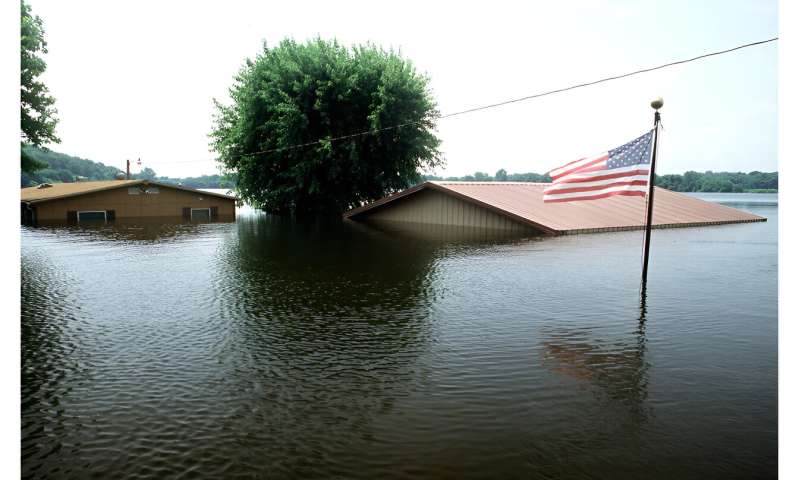Decaying levees put minority and poor communities disproportionately at risk

On the coastline, along riverbanks, and in other low-lying areas, levees are built to keep floodwaters and storm surges contained. These structures are rapidly degrading across America, and the people living behind them are at risk of significant loss and displacement.
According to a new study conducted by Tufts University professor of civil and environmental engineering Farshid Vahedifard, his graduate student Mohammed Azhar and Dustin Brown of Mississippi State University, the make-up of communities living behind these levees skews significantly to minorities, people with disabilities, and individuals and families with lower income and lower levels of education.
Almost 36 million people in the U.S. reside in areas protected by a levee as documented in the National Levee Database, but the actual population living behind levees is potentially much larger. That's because many undocumented levees were originally built by farmers and settlers decades to centuries ago to protect their crops and livestock from flooding, and urbanization has evolved their purpose to protect residential and business communities from flood damage.
These levees were not built with rigorous design codes and construction practices. The American Society of Civil Engineers declared that most U.S. levees are "below standard, with many components at the end of their service life." To make matters worse, the risk faced by vulnerable communities living behind these levees is compounded by increasingly severe weather events and sea-level rise brought on by climate change.
"The results of this study were eye-opening," said Vahedifard, who also serves as the resilient and equitable infrastructure lead with the United Nations University Institute for Water, Environment and Health. "We are hoping that it will encourage efforts to mitigate the risk and fulfill our obligation to protect these communities who otherwise have to face an outsized burden with undersized resources." The study was published in the journal "Earth's Future", and released in a report, Inequities Behind Levees, by the United Nations University, Institute for Water, Environment and Health. .
The challenges and expense of updating and adapting U.S. infrastructure to climate change will be formidable. Vahedifard noted the detailed study, which mapped out both geographic and demographic hotspots, can help prioritize and target these efforts.
The key metric for the study was the disparity in populations at risk—basically a measure of how much more concentrated a population might be behind the levees vs. those in the region who are on higher ground and not in danger. For example, if Blacks make up 15% of the general population on high ground, but 45% behind a levee, then they are three times more concentrated behind the levee, so the disparity would be 300%.
Vahedifard looked at disparity levels for different minorities and underserved populations, named in the study as Hispanics, Blacks, native Americans, Asians, those with disabilities, and people with low income, or low levels of education. He also broke down the analysis nationally, by region, by state, and by levee condition.
The study additionally examined a segment of the population defined as "disadvantaged" based on the Climate and Economic Justice Screening Tool. This category includes individuals and families burdened by multiple factors including climate change, energy access, health care, housing, historical pollution, transportation, and water infrastructure.
Disadvantaged communities are overrepresented behind levees in 43 states, with a national disparity of 41 percent. Hispanics are the most overrepresented minority in leveed areas nationally with a disparity value of 40 percent, followed by Native American, Asian, and Black communities, with disparities ranging from 16 to 19 percent.
The disparities become more pronounced when looking at specific regions and states. The Northeast and West had the highest disparity, with 57 percent and 51 percent of disadvantaged communities living behind levees. In Southeastern states, the disparity in exposure of Hispanic communities to levee failure is over 60 percent. For Black populations, the disparity is most severe in Midwestern states, also at 60 percent.
Looking at income levels, Western states fared poorly with 41 percent more low-income families in leveed areas than in safer non-leveed neighborhoods. Nationally, there is only a slight increase of disabled populations behind levees, but in the Northeast, there is a disparity of 30 percent of individuals with any form of disability living in at-risk areas behind levees.
State by state, the disparity numbers can be alarmingly high. There are high levels of disparity for Black populations behind levees in Kentucky (284 percent) and Tennessee (156 percent). Disadvantaged populations in levee zones in Utah, Connecticut, Rhode Island, and Georgia can be twice as high as they are on safer ground, and in Vermont, the difference is more than six-fold.
"No matter how you slice it, vulnerable, underserved populations are concentrated in areas that are likely to experience some of the worst effects of climate change and infrastructure decay," said Vahedifard. "This study gives us a powerful toolset to allow engineers, social scientists, and policymakers to identify and focus on restoring infrastructure and climate resilience where it is needed the most."
More information:
Farshid Vahedifard et al, Overrepresentation of Historically Underserved and Socially Vulnerable Communities Behind Levees in the United States, Earth's Future (2023). DOI: 10.1029/2023EF003619
Provided by Tufts University